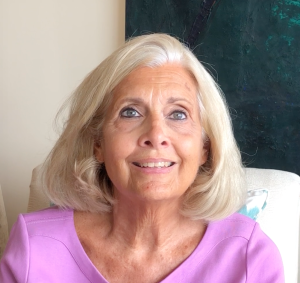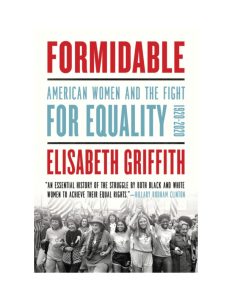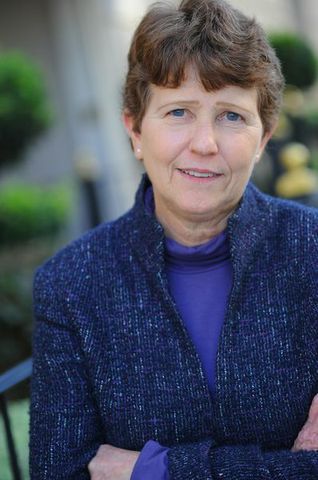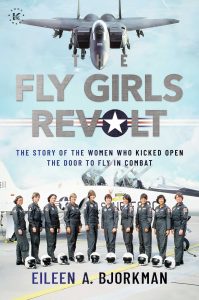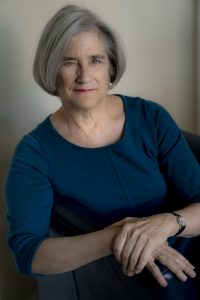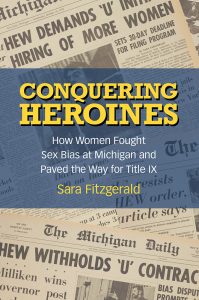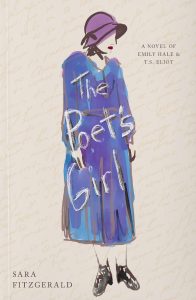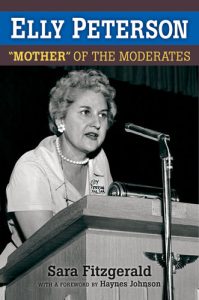Talking About Women’s History: Three Questions and an Answer with Elisabeth Griffith
Historian Elisabeth Griffith is an academic, activist, author, and expert on American women’s history. Her biography of suffragist Elizabeth Cady Stanton, IN HER OWN RIGHT, was hailed by both Oprah and the Wall Street Journal as “one of the five best books on women’s history.” It was the basis of Ken Burns’ documentary on Stanton and Anthony, NOT FOR OURSELVES ALONE, his only film about women’s history.
According to the Los Angeles Times, Betsy’s new book, FORMIDABLE: AMERICAN WOMEN AND THE FIGHT FOR EQUALITY, 1920-2020, is a “thorough and thoughtful” account of the struggles of white and Black women to expand their rights. The New York Times review found FORMIDABLE an “engaging, relevant, sweeping chronicle. [Griffith delivers a] multiracial, inclusive timeline of the struggles and triumphs of both Black and white women. A profoundly illuminating tour de force.”
A graduate of Wellesley College with a doctorate from American University, Betsy has been teaching women’s history for forty years. She marched for women’s rights in the 1970s with the National Women’s Political Caucus, before she led the Women’s Campaign Fund, a forerunner of Emily’s List. Her twenty-two-year tenure as headmistress of the Madeira School, a girls’ boarding and day school in McLean, Virginia, earned the Washington Post’s Distinguished Educational Leadership Award. A member of the Society of American Historians and Veteran Feminists of America, she has been a Kennedy Fellow at Harvard and a Klingenstein Fellow at Columbia.
Take it away, Betsy!
One of the questions I’m fascinated with right now is how biographers name their subjects, particularly when writing about a woman. You briefly discuss that subject in the introduction to Formidable. Where do you come down on the first name/last name question, absent any complicating factors?
When writing about the lives of men, biographers don’t have to worry about what to call their subjects. George Washington advanced from young George to Master George to Lieutenant Washington to General to Mr. President. He was always George Washington. In comparison, his wife was born Martha Dandridge, took her first husband’s name, and became the Widow Custis. When she married George, she was the General’s Lady. After her husband’s election, she was frequently called Lady Washington. The term “First Lady” appeared in 1838 and referred to Martha Washington.
The only name most women keep is their first. They exchange their fathers’ names for that of their husbands. For a married woman to keep her “birth” or “maiden” name was once both illegal and an act of feminist rebellion. Elizabeth Cady Stanton combined her father’s and husband’s names; Lucy Stone refused to take Henry Blackwell’s name. Neither woman vowed to obey their husbands. When Massachusetts granted limited local suffrage to women in 1879, the state insisted that Stone register in her married name. She refused, and never voted.
Francis Perkins, FDR’s Secretary of Labor, was another member of the “Lucy Stone League” of women who kept their birth names. Today, 68.5% of women take their partner’s names, even in 49% of LGBTQ marriages; 22% keep their birth names, and 8.9% use hyphens or create a new surname. The number of women keeping their own names is increasing among highly educated and high earning women, those who marry later, celebrities, and women committed to their personal “brand.” Maybe those women expect to become the subjects of biography.
Biographers of women who adopt married names, possibly more than once, face the naming quandary. Using only their first names, for consistency, seems disrespectful or dismissive once they become adults. To call married women by their married names leads to confusion with their husbands. For clarity in my biography of Elizabeth Cady Stanton, I call my subject Stanton and referred to her husband as Henry.
The more important issue is the act of naming women. “Say Her Name!” was the entreaty and demand of Black activists, that we acknowledge the Black women as well as the men who were victims of police violence. Historians of women want more women to be visible, remembered, respected, incorporated into the canon and included in the curriculum. While more and more notable women are being introduced to students and general readers, there are even more women whose names we will never know.
· Those of Native women whose tribes were by murdered by conquerors or germs or famine and whose descendants’ names were changed in government boarding schools.
· Those who were seized, enslaved, packed into slave ships, auctioned, raped, tortured, forced to give up their children, given the names of their owners, whose descendants fought for their rights for decades, with toilet paper and toothbrushes in their purses, anticipating beatings and jail.
· Women who crossed the plains, whose deaths are still marked by a cairn of stones.
· Women who worked in shoe factories or textile mills whose names only appear in census records or city directories.
· Immigrants whose names were misspelled on ship manifests or at border crossings.
Whether we know their names or not, we need to acknowledge the contributions women made to the creation of our country.
There are too many to name.
Do you think Women's History Month is important and why?
It started with a week and it was never enough. Not enough time to recover and incorporate the lives and stories of the people ignored by the general narrative. That narrative, like all history, “was written by the winners,” who, in America, were mostly white men: the explorers, exploiters, frontiersmen, military leaders, statesmen, inventors, entrepreneurs, and politicians.
Over time, the American story became more inclusive and accurate as more perspectives were included and more primary sources were uncovered. Some accounts were lost with their original languages. Some were never written down by people forbidden to read or write. Other potential narrators were too poor or overworked to leave a record. Many were purposely ignored or silenced.
American history became more inclusive after the Second World War, when the mostly white beneficiaries of the GI Bill used its benefits to attend college. If they enrolled in history graduate school, these “social historians” wrote about soldiers, immigrants, factory workers, and farmers, still mostly men, but widening the lens.
To recover lost Black voices, Carter G. Woodson founded the Journal of Negro History in 1916. He published articles about slavery and professors from Fisk University collected stories from its survivors. On February 7, 1926, Woodson established Negro History Week. “If a race has no history, it has no worthwhile tradition,” he declared, “it stands in danger of being exterminated.”
Black communities had been honoring Lincoln since his assassination and segregated schools in Washington, DC, dedicated another day in February to teaching about Frederick Douglass. Woodson wanted to honor more than great men. Encouraged by Black churches and newspapers, by 1929 cities and states with sizable Negro populations adopted sundry teaching plans and classroom materials. By the end of the 1960s, Black history was offered more widely. During the 1976 celebration of the Bicentennial, President Gerry Ford recognized the value of Black History Month.
When draft boards denied academic deferments during the Vietnam war, graduate programs admitted more women. If they pursued women’s history, they confronted scarce source material. In 1970, Laura X, who like Malcolm X would not use her “owner’s name,” established the Women’s History Research Center, to collect archival materials and promote women’s history as an academic field. Credited with coining the term “herstory,” she launched a campaign to commemorate women’s history.
In 1978, a California county Commission on the Status of Women organized a Women’s History Week, to correspond with International Women’s Day, March 8. In 1980, President Carter made the week a national celebration. In 1987, the Congress created Women’s History Month. May became Asian-Pacific Islander Month and Jewish American Heritage Month. Hispanic History Month spans September and October, to incorporate what used to be known as Columbus Day and is now Indigenous People Day. Franklin Roosevelt established Columbus Day in 1937, to appeal to Italian American and Catholic voters. Politics has long played a role in how we acknowledge our past. The Daughters of the Confederacy rewrote the history of slavery and the Civil War into a cavalier myth of the Lost Cause.
All of these Americans, all of their stories, positive and negative, deserve more than a few weeks of attention. Our schools need to incorporate these narratives into lesson plans, and confront political pushback with facts. Every American deserves to know our whole history, in its full, rich, diverse, flawed, and glorious complexity.
You have spent your career teaching women’s history at a secondary and college level. What aspects of women's history surprise your students most? What outrages them?
I’m passionate about teaching women’s history, as the length of my answers to earlier questions might indicate. I find it hard not to add one more fact or footnote.
I’m fortunate to have graduated from a women’s college at the cusp of the revival of the women’s movement in the 1970s. I had no classes in women’s history in any school I attended, although I did write a paper about mid-nineteenth century divorce and custody laws in a British history course. Noted historian Lady Antonia Fraser has expanded on that topic in her latest book, The Case of the Married Woman: Caroline Norton and Her Fight for Women’s Justice (2022).
But the combination of an institution led by women, in which students were challenged to use their brains and their leadership skills, and the energy exploding out of civil rights, anti-war and women’s rights protests fueled my interest in learning more. I moved to Washington, DC, enrolled in graduate school, and volunteered for the National Women’s Political Caucus.
The Caucus has been founded in 1971 as a bipartisan organization to elect more women and ratify the Equal Rights Amendment. Record keeping was casual and recollections were contradictory. In one creation myth, the first meeting of the NWPC was in a chapel on a junior college campus in DC. None of the organizers or the journalists covering it or anyone else knew enough women’s history to recognize the parallel to the first formal women’s rights convention in America, held in a Methodist chapel in Seneca Falls, NY, in July 1848.
I signed on, marched, lobbied, and was shouted at by both Bella Abzug and Betty Friedan. My actual tasks were more mundane. In anticipation of the first NWPC national membership gathering, in January 1973, I was put in charge of creating a backdrop behind the podium. This was long before “pipe and drape” setups or electronic screens displaying an organization’s logo. After I secured an American flag and some ficus trees, the setting still seemed anonymous. I wanted to signal that fighting for women’s rights was not a new proposition.
My search took me to the Smithsonian National Museum of American History, where I met the curator of political history, Edie Mayo. She led me into the back rooms where drawers held photographs of the founding feminists. I recognized Elizabeth Cady Stanton, Susan B, Anthony, Lucretia Mott and Sojourner Truth, but not Matilda Jocelyn Gage, Francis Ellen Watkins Harper, Carrie Chapman Catt, Ida B. Wells, Mary Church Terrell, or so many other unacknowledged foremothers.
We reproduced and enlarged the black-and-white photos of these old, wrinkled, care worn, unsmiling women, mostly wearing business black, and shipped them off, to post behind the podium and across the stage. Identifying them became an pop quiz.
Meanwhile, I’d chosen my dissertation topic, a biography of Elizabeth Cady Stanton, the principal organizer, with Lucretia Mott, of the 1848 convention. Stanton was the first to demand voting rights for women. In the history department at my university, there were no specialists in American women’s history. The only female, tenured, full professor was an expert on ancient Greece, but she was an ally and served as the only woman on my dissertation committee.
I was also teaching part-time at an independent girls’ high school, because it did not require a teaching certificate. I got the job because the head of the English department, who had been my teacher in public school in Michigan, introduced me to the head of the history department. We were all alumnae of the same women’s college. I was invited to reach a course about US politics, which allowed me to cover women in politics and in the streets. The Congress had passed the Equal Rights Amendment after Martha Griffiths (D-Michigan) freed it from the House Judiciary Committee, where it had been held hostage since 1943. The Supreme Court had decided Roe. Phyllis Schlafly had not yet joined the fray.
My new boss found funding for me attend the Berkshire Women’s History Conference. Founded in 1930 by women who felt marginalized in a profession dominated by white men, the “Berks” began as a series of weekend retreats in the Berkshire Mountains. It was reinvigorated in 1973 at Douglass College, Rutgers University. I returned, inspired if unprepared to teach one of the first women’s history courses at the high school level.
I’ve been teaching women’s history ever since – to diverse audiences, to boys and girls, to men and women, to Girl Scouts, high school students, undergraduates, women running for office, adults in lecture halls and bookstores, at corporate retreats, at dinner tables, with speeches, in books, articles and media appearances. The responses are always the same. “OMG! Who knew?” It’s a challenge, especially for young people, to imagine the lives of women decades or centuries ago – the lack of rights, the physical hardship, the early deaths brought on by exhaustion and childbirth, the lack of opportunity, the constricting clothing and confining laws. People find women’s history engaging, compelling, outraging, and empowering. It is.
A question from Elisabeth: What is the role of political leaders in defining the purpose and content of teaching American history?
In the best of worlds, I believe political leaders should play no role in defining the purpose and content of teaching American history—or any history for that matter. In prior years we left plenty of people out of the historical picture in the classroom, and we were all the worse for it. But that neglect was a result of cultural blindness, not a matter of official policy. Turning curricula into political battlegrounds is not the answer.
* * *
Want to know more about Elisabeth Griffith and her work? Check out her website: https://www.elisabethgriffith.com/
***
Come back tomorrow for three questions and a answer with historian Susan Ware.
Talking About Women’s History: Four Questions and an Answer with Eileen Bjorkman
Eileen Bjorkman is a writer and retired Air Force colonel. She is the author of three books, including The Fly Girls Revolt: The Story of the Women Who Kicked Open the Door to Fly in Combat, which will be released in May. She has also had numerous articles and essays published in many outlets, including The Washington Post, Time.com, Air & Space, and Aviation History.
Take it away, Eileen!
What inspired you to write The Fly Girls’ Revolt?
I've read a lot of recent memoirs about women who have flown in combat in the past 20 years or so. And there are plenty of books about the Women Airforce Service Pilots in World War II, a group of about 1,000 civilian women who ferried military aircraft and did other support flying during the war. But there are almost no books about the women of my generation who served in the military in the 1970s and 1980s. This is the first generation of women who trained as military pilots, but could only fly support aircraft. These women led the charge to open the door in 1993 to allow women to fly combat aircraft. The full story that gives credit to everyone involved in making the change has never been told, so I wanted to tell that story. And the story isn't just about women aviators; it's about all the women who served and proved they belonged, along with those who supported them along the way, such as members of Congress and lawyers, including an unknown lawyer in the 1970s, Ruth Bader Ginsburg.
We’re all familiar with the challenges of finding sources for writing about women from the distant past. What are the challenges of writing about women from the late twentieth century?
The biggest challenge I had was finding materials in archives. A lot of material from that time period in military archives is still marked "For Official Use Only" or is still considered classified, even if the normal 25 year point for declassification has passed. I likely could have accessed some of the materials I wanted if I'd had time to file FOIA (Freedom of Information Act) requests, but I was on a tight timeline because I wanted to get the book published to coincide with the 30th anniversary of opening the door to combat in 1993. I'm not sure it made that much difference overall because I was able to learn much of what I needed by interviewing women, but some of the official sources would have been nice for fact checking and providing another perspective. Another challenge was that some of the archival material I used was recently donated and hadn't yet been organized. I had to examine every single document in about a dozen boxes to see if it had any relevance to my research. I enjoyed looking at all the documents, but again, I was short on time, so some better organization might have helped. Last, a lot of the archival materials had maiden names in them, so I sometimes had to chase down who was who and what their current name was if I needed more information or wanted to check something. Fortunately, the Women Military Aviators association was able to help me find most of the women.
Did your own experience as a military aviator shape the writing of The Fly Girls’ Revolt?
Yes, definitely. I was a flight test engineer, not a pilot, and because of that, I was able to fly in the back seat of fighter aircraft because the airplanes we used for testing weren't considered combat aircraft. From my own experiences, I knew that women were fully capable of flying combat aircraft, so I was a big proponent of opening the door, even though it didn't impact me personally. I followed the news on women aviators very closely, and I knew some of the women who were working hard to get into combat. Knowing the basic story and some of the women helped shape my research from the beginning, as I knew which events I wanted to cover. I of course discovered some other things during my research that I included, but knowing the basic outline helped me focus. I also knew that I wanted to put myself into the story in a few places since I had the experience of being one of a handful of women who flew in fighters before it was allowed. I wanted to talk about some of the issues I encountered, as well as my ability to navigate the fighter and test pilot cultures to be part of the team.
What was the most surprising thing you've found doing historical research for your work?
I'd have to say it was learning that some things were not exactly the way I remembered them from the 1980s. I had some misperceptions about the Reagan administration's attitudes towards women in the military because of what I'd observed as a young woman. I found during my research that I was wrong. I also learned things about one of the main characters that led me to write about her in a different way than many writers have previously. Having access to original source documents was very helpful in changing my mind about how to portray certain events and people. I think the biggest lesson learned is that, even if you've lived something, you still need to do research!
A question from Eileen: Why is it important to tell the stories of historical women today?
It’s really pretty simple. In her book, Headstrong, journalist Rachel Swaby describes the process of treating historical women scientists as scientists rather than anomalies or moonlighting wives and mothers as “revealing a hidden history of the world.” That’s true whether you are talking about scientists, or activists, or aviators, or journalists, or artists, or factory workers. When you put half the population back into history, you get a very different story.
* * *
Want to learn more about Eileen and The Fly Girls’ Revolt?
Check out her website: https://eileenbjorkman.com
Follow her on Twitter: @AviationHistGal
Follow her on Facebook: https://www.facebook.com/AviationHistGal/
* * *
Come back tomorrow for Three questions and an answer with historian and activist Elisabeth Griffith
Talking About Women’s History: Three Questions and an Answer with Sara Fitzgerald
Sara Fitzgerald is an author and retired journalist who has been researching the untold stories of little-known women since she earned a bachelor’s degree in honors history from the University of Michigan in 1973. Her journalism career included 15 years as an editor and new media developer for The Washington Post. In 2020, the University of Michigan Press published her book Conquering Heroines: How Women Fought Sex Bias at Michigan and Paved the Way for Title IX in connection with the 50th anniversary of the so-called “HEW complaint” and the 150th anniversary of the admission of women to Michigan. Fitzgerald covered the complaint as a staff member of The Michigan Daily, the U-M student newspaper; in 1972, she became the first woman to serve as its editor in chief. In 2013, Fitzgerald contributed a project on the Michigan complaint to Volume 17 of “Women and Social Movements in the United States: 1600-2000.” Fitzgerald is also the author of a biography, Elly Peterson: ‘Mother’ of the Moderates (University of Michigan Press, 2011), which was recognized by the Historical Society of Michigan and as a Notable Book of the Year by the Library of Michigan. She is also the author of the 2020 novel The Poet’s Girl, and now is completing a biography on the subject of that novel, Emily Hale, the longtime secret muse of the poet T. S. Eliot.
Take it away, Sara!
When did you first become interested in women’s history? What sparked that interest?
I attended the University of Michigan between 1969 and 1973. It was a time of great turmoil on campus—and a time of great change for women. It was during those years that Ms. Magazine was created, the National Women’s Political Caucus was founded, the Equal Rights Amendment first cleared Congress, and the Supreme Court affirmed the reproductive rights of women in its Roe v. Wade decision. At the end of my freshman year, a group of women filed a sex discrimination complaint against the university that was ultimately successful in forcing Michigan to change some of its long-standing, discriminatory practices. At that time, it was revealed that admissions officers had imposed a quota of 55 percent men: 45 percent women for my freshman class, because they were concerned about what one described as a potential “over-balance” of women in my class because women had been out-performing men in high school.
I started off as a journalism major, but by my junior year, I decided to make history my main field of study. It was a time when women professors were eager to research and teach topics related to women’s lives, even if they had to hold the courses in their living rooms, as one of my professors was forced to do. Within a few years, these professors established the Women’s Studies Program at Michigan.
I was lucky to get to know Kathryn Kish Sklar, a pioneer in the field of women’s history. (Kitty’s biography of Catherine Beecher was a finalist for the National Book Award for Biography in 1974.) As I pursued my courses in history, I always looked for a fresh topic related to women to research and write my papers about. The summer before my senior year, I read Nancy Milford’s ground-breaking biography of Zelda Fitzgerald and decided to write my senior thesis on the flapper phenomenon. When I retired from a career in journalism and public policy work and looked around for what to do next, I realized how much I had enjoyed researching and writing about the lives of women, and returned to those roots.
Did you have a woman (or group of women) from the past who inspired you as a child?
My parents were moderate Republicans, and in 1964, I was watching television coverage of the Republican National Convention when I was astounded to see network correspondents interviewing a woman named Elly Peterson. I think I took note of her because it was so rare to see a woman on the political stage back then, and I was proud that she came from my home state of Michigan. At that time, she was the highest ranking woman in the national Republican Party, she was running for a Senate seat from Michigan, and she was about to become the first woman to address a national presidential convention in prime time. She did not win her Senate race, but she got on my radar screen. During my college years, she became one of the Republican leaders of the National Women’s Political Caucus after it was founded. Then in 1976, she was recruited, along with Democrat Liz Carpenter, to chair ERAmerica, the coalition of groups that was organized to work for ratification of the Equal Rights Amendment, to try and counter the opposition of Phyllis Schlafly.
As fate would have it, I got to meet Peterson a few years later when she moved to the same retirement community in North Carolina where my parents lived. She was a true “people” person, friendly and outgoing, and later sent me some “fan mail” about a novel I wrote at the time.
When I retired earlier than I had expected, I reflected that she was one of those little-known women of our history who deserved to be better known. She had since moved to Colorado, but I was able to track her down and explore whether she was interested in working with me. In the end, I wrote her biography. She was supportive of the project, but it was not an “authorized” biography, per se. But it was a very satisfying project, and I was only sorry that I was not able to complete the book before she died—two days after Hillary Clinton formally ended her first presidential campaign in 2008.
How does your experience as a journalist inform your work as a biographer?
Biographers need to get inside the heads of their subjects, but I find I have to push myself to go beyond the known facts of a person’s life. I am currently working on a biography of Emily Hale, the longtime secret love of the poet T. S. Eliot. I previously wrote a novel about her, but after their lengthy correspondence was opened in 2020 after a fifty-year embargo, I decided to write a more traditional biography. So I’m now trying to be more careful about what is known about her and what is just speculation—or taken as fact because Eliot wrote it. Most of the scholars who are writing about Hale and Eliot come from the discipline of English literature and are primarily interested in analyzing Hale’s impact on Eliot’s poetry and plays—an approach that is much more subjective, I think, than historical analysis. I’ve also come to realize that because Hale was, by nature, a very private, reticent person, her story was ultimately written by others, some of whom got significant facts wrong or distorted her motivations. I think my experience as a journalist motivated me to try and “set the record straight.” I think I’ve also been able to use my reporting skills to turn up new details about her life and “connect the dots” in fresh ways.
A question from Sara: As a professional historian who seeks to translate history for popular audiences, what are your thoughts about how history is being taught—or not being taught—in schools and colleges today?
Not an easy question, and no easy answers.
That said, I think as a group, the United States has not done a good job of teaching history in a way that includes our nation as a whole.* That is the reason that Women’s History Month, Black History Month and all the other ethnic heritage months exist. It is also the reason groups like the Remedial Herstory Project exist —to provide teachers with resources about historical subjects that are not included in classroom textbooks.
I am heartened by the numbers of people who are struggling to confront the parts of our history that we never learned. I cheer whenever I visit a museum that explicitly expands the story to include the uncomfortable parts, as well as adding women and and people of color back into the narrative. It is hard and it is uncomfortable. Over and over I am confronted by the blind spots in my own historical knowledge, and the accompanying pain in the pit of my stomach.**
At the same time, I am tremendously distressed by attempts to make whitewashing history a matter of policy rather than of collective cultural blindness, as well as by the attempt to gut or remove history departments.
*With the acknowledgement to my non-American readers, I’m going to be talking only about the United States here.
**If you are interested in a thoughtful discussion of this subject, I strongly recommend A More Just Future by Dolly Chugh. If you want to read an account of American history that deals directly with our collective blind spots, On Juneteenth by Annette Gordon-Reed is a wonderful entry point.
* * *
Want to know more about Sara Fitzgerald and her work?
Check out her website: www.sarafitzgerald.com
Check out her blog: Notes from a Chronicler of Little-Known Women https://sarafitzgeraldcom.wordpress.com/
* * *
Come back tomorrow for four (!) questions and an answer with Eileen Bjorkman, author of The Fly Girls Revolt
